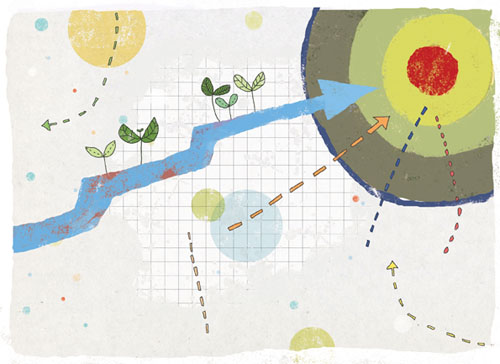By Pete Wilson
There is a lot of energy today around innovation in government. This is a good thing. Government agencies, like all large organizations, can fall into a complacent bureaucratic model that fiercely protects established structures, processes, and cultures. When they do, they can become unresponsive to the evolving needs of customers, partners, and their own internal coworkers. Innovating processes, tools, and cultures ensures that the organization is adaptive and prepared to address change when it is needed.
At the core of innovation is simply to do, or use, something new. People resist innovation efforts for a variety of reasons, not the least of which is the concern over the magnitude of change. However, the path to successful innovation is not necessarily a large-scale transformation project. Innovation is often the result of many small, sometimes independent, efforts to produce new or enhanced products or services within a culture that invites new ideas and experimentation. I like to call these small innovation efforts “minnovations.”
So, why does minnovation work? In short, minnovation rapidly delivers solutions through creativity and experimentation, without enormous risk. Here’s how:
Creativity. Minnovation empowers small teams or individuals to exercise their ideas. If empowered to innovate on a small scale, individuals and teams can generate valuable solutions while also finding new energy and enthusiasm about what they do and can offer.
Experimentation. Minnovation offers the added dimension of experimentation. Experimentation teaches individuals to learn from experience. This learning is then applied to refine hypotheses, approaches, and components of a solution to incrementally shape something of new – and sometimes breakthrough – value.
Mitigated risk. Minnovation avoids the risks associated with a failed large project because financial and time costs are low for small, short-term efforts. The costs, or perceived losses, associated with a small endeavor are far more palatable than those of a mid-size or large project. OMB’s “Fail Fast” approach is an incarnation of this idea. Keep in mind that Fail Fast does not mean: fail, forgive, and forget; rather, it emphases rapid, incremental, adaptive delivery where organizations learn and grow. In short, it means minnovation.
So how do you apply minnovation within your organization? Here are a few suggestions.
- Work small but think big. Capitalize upon small efforts and experimentation to achieve your larger objectives.
- Empower individuals and teams to generate new ideas. Create opportunities for people to generate and cultivate ideas. Provision tools and facilities for people to share, collaborate, and experiment.
- Provide integration and processes standards for innovators. Standards are the glue for process and product innovation. Incompatible creations can perpetuate and as they do, the luster of innovation will begin to fade. Arm innovators with the means to integrate with existing products or systems.
- Do not discard what does not have immediate value. What does not have value right away or that is immediately evident to you, might be just what is needed by another division today or what is needed in a year’s time. Manage an innovation inventory that enables others to discover, understand, and use your innovation outputs.
- Record and learn from your innovation activities. As people experience the innovation process, their perspectives and techniques can be shared to cultivate a learning organization in which evolutionary discovery is valued and encouraged.
Minnovation fosters organizational agility and provides an avenue for employees to contribute in diverse and rewarding ways. Big change is hard and risky, and many times your initial concept of what will work is wrong. Minnovation enables you to lower your risk, try new things, and learn to deliver and manage positive change incrementally.
Are you ready to take that first small step?





Leave a Reply
You must be logged in to post a comment.